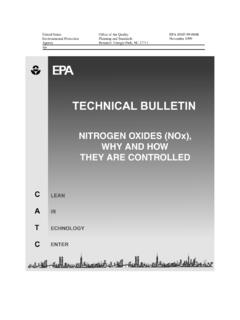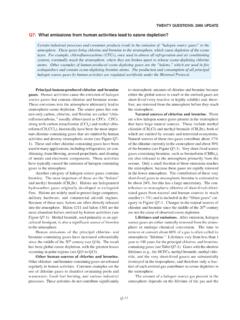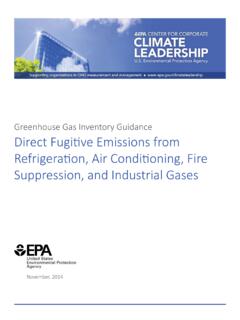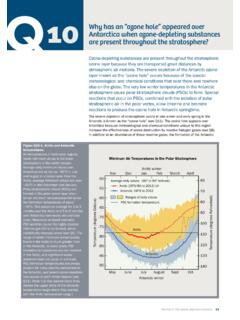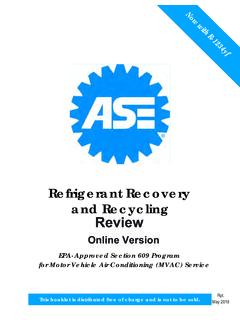Transcription of Criteria Air Pollutants
1 Environments and Contaminants | Criteria Air Pollutants America s Children and the Environment | Third Edition, Updated October 2015 1 Criteria Air Pollutants Air pollution contributes to a wide variety of adverse health effects. EPA has established national ambient air quality standards (NAAQS) for six of the most common air Pollutants carbon monoxide, lead, ground-level ozone , particulate matter, nitrogen dioxide, and sulfur dioxide known as Criteria air Pollutants (or simply Criteria Pollutants ). The presence of these Pollutants in ambient air is generally due to numerous diverse and widespread sources of emissions. The primary NAAQS are set to protect public health. EPA also sets secondary NAAQS to protect public welfare from adverse effects of Criteria Pollutants , including protection against visibility impairment, or damage to animals, crops, vegetation, or buildings. As required by the Clean Air Act,1 EPA periodically conducts comprehensive reviews of the scientific literature on health and welfare effects associated with exposure to the Criteria air The resulting assessments serve as the basis for making regulatory decisions about whether to retain or revise the NAAQS that specify the allowable concentrations of each of these Pollutants in the ambient The primary standards are set at a level intended to protect public health, including the health of at-risk populations, with an adequate margin of safety.
2 In selecting a margin of safety, EPA considers such factors as the strengths and limitations of the evidence and related uncertainties, the nature and severity of the health effects, the size of the at-risk populations, and whether discernible thresholds have been identified below which health effects do not occur. In general, for the Criteria air Pollutants , there is no evidence of discernible The Clean Air Act does not require EPA to establish primary NAAQS at a zero-risk level, but rather at a level that reduces risk sufficiently so as to protect public health with an adequate margin of safety. In all NAAQS reviews, EPA gives particular attention to exposures and associated health risks for at-risk populations. Standards include consideration of providing protection for a representative sample of persons comprising at-risk populations rather than to the most susceptible single person in such groups. Even in areas that meet the current standards, individual members of at-risk populations may at times experience health effects related to air Childhood is often identified as a susceptible lifestage in the NAAQS reviews, because children s lungs and other organ systems are still developing, because they may have a preexisting disease ( , asthma), and because they may experience higher exposures due to their activities, including outdoor Evaluating the effects of Criteria air Pollutants in children has been a central focus in several recent NAAQS reviews, including revisions of the lead,18 ozone ,19 and particulate matter20 standards to strengthen public health protection.
3 Some of the air quality standards are designed to protect the public from adverse health effects that can occur after being exposed for a short time, such as hours to days. Other standards are designed to protect people from adverse health effects that are associated with long-term Criteria Air Pollutants | Environments and Contaminants 2 America s Children and the Environment | Third Edition, Updated October 2015 exposures (months to years). For example, the standard for ozone is based on pollutant concentrations measured over a short-term period of eight hours. By contrast, the standard for lead considers average concentrations measured over a rolling three-month period. For fine particulate matter ( ), annual and 24-hour standards work together to provide protection against effects associated with long- and short-term exposures. Health effects that have been associated with each of the Criteria Pollutants are summarized below.
4 This information is drawn primarily from EPA s assessments of the scientific literature for the Criteria Pollutants . ozone Ground-level ozone forms through the reaction of Pollutants emitted by industrial facilities, electric utilities, and motor vehicles; chemicals that are precursors to ozone formation can also be emitted by natural sources, particularly trees and other Ground-level ozone can pose risks to human health, in contrast to the stratospheric ozone layer that protects the earth from harmful wavelengths of solar ultraviolet radiation. Short-term exposure to ground-level ozone can cause a variety of respiratory health effects, including inflammation of the lining of the lungs, reduced lung function, and respiratory symptoms such as cough, wheezing, chest pain, burning in the chest, and shortness of ,13,21 ozone exposure can decrease the capacity to perform Exposure to ozone can also increase susceptibility to respiratory infection.
5 Exposure to ambient concentrations of ozone has been associated with the aggravation of respiratory illnesses such as asthma, emphysema, and bronchitis, leading to increased use of medication, absences from school, doctor and emergency department visits, and hospital admissions. Short-term exposure to ozone is associated with premature Studies have also found that long-term ozone exposure may contribute to the development of asthma, especially among children with certain genetic susceptibilities and children who frequently exercise Long-term exposure to ozone can permanently damage lung tissue. Particulate Matter Particulate matter (PM) is a generic term for a broad class of chemically and physically diverse substances that exist as discrete particles (liquid droplets or solids) over a wide range of sizes. Particles originate from a variety of man-made stationary and mobile sources, as well as from natural sources such as forest fires.
6 Particles may be emitted directly, or may be formed in the atmosphere by transformations of gaseous emissions such as oxides of sulfur (SOx), oxides of nitrogen (NOx), and volatile organic compounds (VOCs). The chemical and physical properties of PM vary greatly with time, region, meteorology, and the source of emissions. For regulatory purposes, EPA distinguishes between categories of particles based on size, and has established standards for fine and coarse particles. PM10, in general terms, is an abbreviation for particles with an aerodynamic diameter less than or equal to 10 micrometers ( m), and represents inhalable particles small enough to penetrate deeply into the lungs ( , thoracic particles).i i For comparison, the diameter of PM10 particles is 1/7 the diameter of an average human hair or less. Environments and Contaminants | Criteria Air Pollutants America s Children and the Environment | Third Edition, Updated October 2015 3 PM10 is composed of a coarse fraction referred to as or as thoracic coarse particles ( , particles with an aerodynamic diameter less than or equal to 10 m and greater than m) and a fine fraction referred to as or fine particles ( , particles with an aerodynamic diameter less than or equal to m).
7 Thoracic coarse particles are emitted largely as a result of mechanical processes and uncontrolled burning. Important sources include resuspended dust ( , resuspended by cars, wind, etc.), industrial processes, construction and demolition operations, residential burning, and wildfires. Fine particles are formed chiefly by combustion processes ( , from power plants, gas and diesel engines, wood combustion, and many industrial processes) and by atmospheric reactions of gaseous Pollutants . Although scientific evidence links harmful human health effects with exposures to both fine particles and thoracic coarse particles, the evidence is much stronger for fine particles than for thoracic coarse particles. Effects associated with exposures to both and include premature mortality, aggravation of respiratory and cardiovascular disease (as indicated by increased hospital and emergency department visits), and changes in sub-clinical indicators of respiratory and cardiac function.
8 Such health effects have been associated with short- and/or long-term exposure to Exposures to are also associated with decreased lung function growth, exacerbation of allergic symptoms, and increased respiratory Children, older adults, individuals with preexisting heart and lung disease (including asthma), and persons with lower socioeconomic status are considered to be among the groups most at risk for effects associated with PM Information is accumulating and currently provides suggestive evidence for associations between long-term exposure and developmental effects such as low birth weight and infant mortality due to respiratory Sulfur Dioxide Fossil fuel combustion by electrical utilities and industry is the primary source of sulfur dioxide in the United People with asthma are especially susceptible to the effects of sulfur Short-term exposures of asthmatic individuals to elevated levels of sulfur dioxide while exercising at a moderate level may result in breathing difficulties, accompanied by symptoms such as wheezing, chest tightness, or shortness of breath.
9 Studies also provide consistent evidence of an association between short-term sulfur dioxide exposures and increased respiratory symptoms in children, especially those with asthma or chronic respiratory symptoms. Short-term exposures to sulfur dioxide have also been associated with respiratory-related emergency department visits and hospital admissions, particularly for children and older Nitrogen Dioxide Nitric oxide (NO) and nitrogen dioxide (NO2) are emitted by cars, trucks, buses, power plants, and non-road engines and equipment. Emitted NO is rapidly oxidized into NO2 in the ii F or , the evidence linking health effects to short-term ( , 24-hour) exposures is stronger than the evidence for effects of long-term exposures. Criteria Air Pollutants | Environments and Contaminants 4 America s Children and the Environment | Third Edition, Updated October 2015 Exposure to nitrogen dioxide has been associated with a variety of health effects, including respiratory symptoms, especially among asthmatic children, and respiratory-related emergency department visits and hospital admissions, particularly for children and older Lead Historically, the major source of lead emissions to the air was combustion of leaded gasoline in motor vehicles (such as cars and trucks).
10 Following the elimination of leaded gasoline in the United States by the mid-1990s, the remaining sources of lead air emissions have been industrial sources, including lead smelting and battery recycling operations, and piston-engine small aircraft that use leaded aviation Lead accumulates in bones, blood, and soft tissues of the body. Exposure to lead can affect development of the central nervous system in young children, resulting in neurodevelopmental effects such as lowered IQ and behavioral Carbon Monoxide Gasoline-fueled vehicles and other on-road and non-road mobile sources are the primary sources of carbon monoxide (CO) in the United Exposure to carbon monoxide reduces the capacity of the blood to carry oxygen, thereby decreasing the supply of oxygen to tissues and organs such as the heart. People with several types of heart disease already have a reduced capacity for pumping oxygenated blood to the heart, which can cause them to experience myocardial ischemia (reduced oxygen to the heart), often accompanied by chest pain (angina), when exercising or under increased stress.










